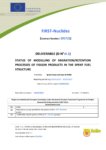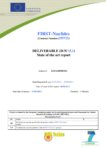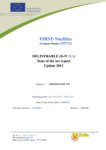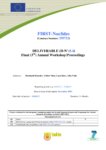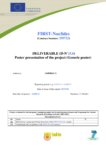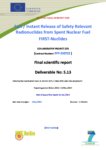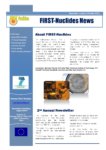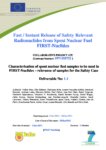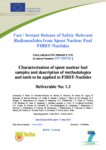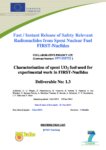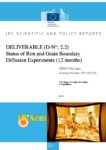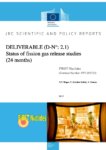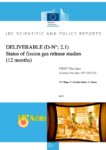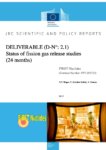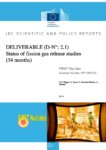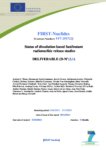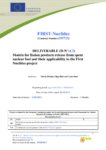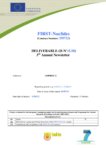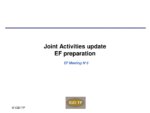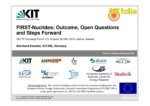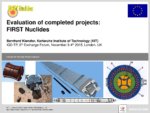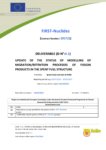FIRST-Nuclides: Fast/Instant Release of Safety Relevant Radionuclides from Spent Nuclear Fuel
First-Nuclides aimed to improve the understanding of the fast / instantly released radionuclides from disposed high burn-up UO2 spent nuclear fuel. The outcome of the project is relevant for all types of host rocks in Europe.
Overview
Project Dates: 01/01/2012 – 31/12/2014
Project Status: Finished
Project website: http://www.firstnuclides.eu/
Deep geological repositories are the preferred choice for long-term management of spent nuclear fuel. The safety of such underground facilities that exploit natural geology and man-made barriers to isolate radioactive waste is demonstrated quantitatively through performance assessment calculations.
EU-funded scientists launched the project FIRST-NUCLIDES (Fast / instant release of safety relevant radionuclides from spent nuclear fuel) to improve the understanding of what happens with such barriers. The team focused on high burn-up spent uranium oxide fuel from pressurised and boiling water reactors.
Burn-up has increased over the past years enabling nuclear plants to get more power out of fuel before replacing it. However, high burn-up makes the spent fuel hotter and more radioactive – two important considerations in designing storage facilities.
Such waste is a source of significant release of radionuclides when a canister fails. Some of the released radionuclides show high solubility in groundwater while others undergo only marginal retention on their way to the biosphere. For safety analysis, researchers need to quantify the release of these radionuclides.
During the FIRST-NUCLIDES project, scientists gathered key input data via experimental investigations and modelling. The results include fission product distribution in fuel pellets, fission gas release after puncturing of spent fuel rods and fission gas and non-gaseous product release from spent fuel in the case of contact with water.
The database created includes the largely unknown ‘instant release fraction’ values of iodine, chlorine, carbon and selenium. All these elements tend to form anionic species that are hardly chemically retained in repository barrier systems.
The data and knowledge obtained should increase the confidence in predictions of the instant release of fission and activation products for spent uranium oxide fuel. In particular, the FIRST-NUCLIDES project has improved understanding of its dissolution behaviour in view of licensing repositories set to be operational by 2025.
Objective
Many European member states consider spent nuclear fuel as a wasteform to be disposed of in a deep underground repository. This project tackled the challenge of realistically describing the release of the first batch of radionuclides from disposed spent nuclear fuel upon canister failure (fast/instant release fraction).
The key objectives of the project consider the disposal of high burn-up UO2 fuel and independent of the host rock under consideration:
- Selection, characterisation and preparation of materials and set-up of tools for handling and transportation of highly radioactive material.
- Experimental determination of fission gas distribution in fuel pellets, gas release after puncturing of high burn-up spent fuel rods or segments and determination of fission gas release from spent fuel in the case of contact with an aqueous phase.
- Experimental determination of rim and grain boundaries inventories and the contribution of these inventories to the fast/instant release.
- Quantification of mechanisms relevant to the release of fission products from fractures, rim and grain boundaries of high burn-up UO2 fuel by diffusion experiments.
- Experimental quantification of the fast/instant radionuclide release when high burn-up spent fuel comes into contact with the aquatic phase. Quantification takes into account the presence or absence of cladding, fuel fragments from different radial positions of fuel pellets and the specific fuel and burn-up characteristics.
- Experimental quantification of the effect of fuel characteristics, burn-up and burn-up history, and of the characteristics of the samples under investigations on fast/instant radionuclide release from high burn-up fuel.
- Implementation of the fast/instant release mechanisms into models which allow prediction of i) chemical speciation of the relevant elements in the spent fuel, ii) relationship between the fission gas release and non-gaseous fission products, in particular 129I, 79Se and 135Cs , and iii) long-term retention of fission products in the rim and onto grain boundaries.
Strategic objectives
- In order to make best possible use of existing knowledge, at the beginning of the project emphasis was given to the evaluation of conceptual models, codes and databases with respect to their use for the project objectives.
- Communication and dissemination objectives ensured that interested parties were informed about the project and its outcome. Within this context, additional groups from different countries were invited to accompany and contribute to the project.
- A group of implementation and regulatory-oriented organisations participated as an “End-User Group”. This group of end-users had a number of functions, including:
- Ensuring that end-user interests were reflected in the project work, reporting, dissemination and communication;
- Providing for review of the project work and scientific-technical outcome in association with periodic project workshops, including review of scientific- technical contributions to the corresponding workshop proceedings; and
- Participating in assessment and discussion of the project outcome with respect to the potential impact on the safety case.




